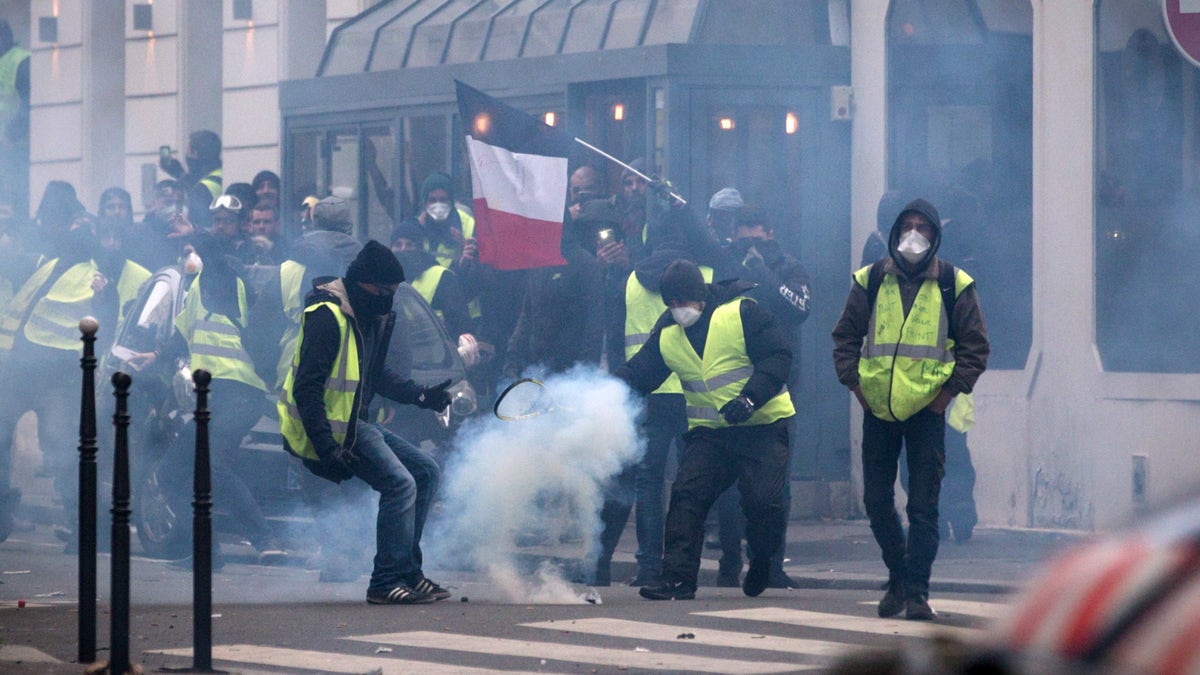Despite a dip in numbers, France’s “yellow vest” protesters continued their demonstrations – and clashed with police in the Parisian streets – for the fifth consecutive weekend.
Officers fired rubber bullets and tear gas at the demonstrators, some of whom were alleged to have set vehicles on fire in the area. Police also used water cannons in an effort to dissipate the masses – there were around 2000 gathered compared to 10,000 in the last week – as the protest turned violent later in the day.
Paris wasn’t the only location that the protests continued. Smaller demonstrations, which attracted hundreds more people, blocked highways and streets in other pockets of the nation and also played out in Brussels, Belgium, close to the European Parliament.
Altogether, 66,000 people turned up to demonstrations on Saturday, a drop from the 125,000 who mobilized the weekend before.
More than 1,700 people were apprehended by authorities for questioning, while 1,220 were taken into custody, according to figures from the Interior Ministry. Many continued to occupy dozens of traffic circles through to Sunday, rebuffing calls from the Interior Minister Christophe Castaner to vacate the traffic circles.
Other reports have pointed to the protests as – for the most part – being “largely peaceful” while the show of force from French police remains significant, with at least 8,000 officers and 14 armored vehicles deployed in Paris alone and some 69,000 assembling nationwide.
Many of those who took to the streets in France over the weekend could again be heard calling for President Emmanuel Macron to step down. The movement, which is largely seen as a rallying cry for economic justice from France’s working class, takes its name from the yellow safety vests French motorists are mandated to keep in their vehicles. The demonstrations were sparked last month in anger over fuel tax increases and have since developed into wider grievances with President Macron ranging from demands for lower taxes, better pensions, and easier university entry conditions.
The ongoing demonstrations have also triggered economic repercussions for the nation in what is generally one of its busiest times of the year for retail and tourism in the lead up to Christmas.

Aurelien Morissard / Fox News; Clashes between police and demonstrators, during a demonstration of the "Yellow vests", in Paris, France, on December 8th 2018.
In anticipation of the unrest, Parisian monuments including the Eiffel Tower and numerous Metro Stations shuttered, and luxury brand stores such as Cartier and Mont Blanc remained closed as protesters shuffled past. The French retail federation estimates that the sector has lost some $1.1 billion since the yellow vest movement kicked off at the beginning of November.
IN VENEZUELAN CRISIS, FAMILIES CAN'T EVEN AFFORD TO PROPERLY BURY THE DEAD
Around 900 have been wounded since the start of the dissent catalyzed on November 17, and at least two have died.
Although seemingly without any clear leader, the movement has received support from both sides of the political spectrum. France’s far-right leader Marie Le Pen has backed the demonstrators, as has the country’s far-left CGT movement. However, French security services are also reported, according to the Wall Street Journal, to be investigating if Moscow is amplifying the movement through social media and fake accounts, which the Kremlin has staunchly denied.
So far, Macron has responded to the revolts by discarding an unpopular fuel tax rise and pledging an additional $114 per month for those who earn a minimum wage as well as tax reductions from pensioners – but to-date, that has proven not to be enough.
ECUADORIANS SAY ASSANGE'S TIME IN LONDON EMBASSY MAY BE NEARING END
Despite the thinning crowds, those who remain insist they are committed and refuse to back down until all their demands are adequately met.

